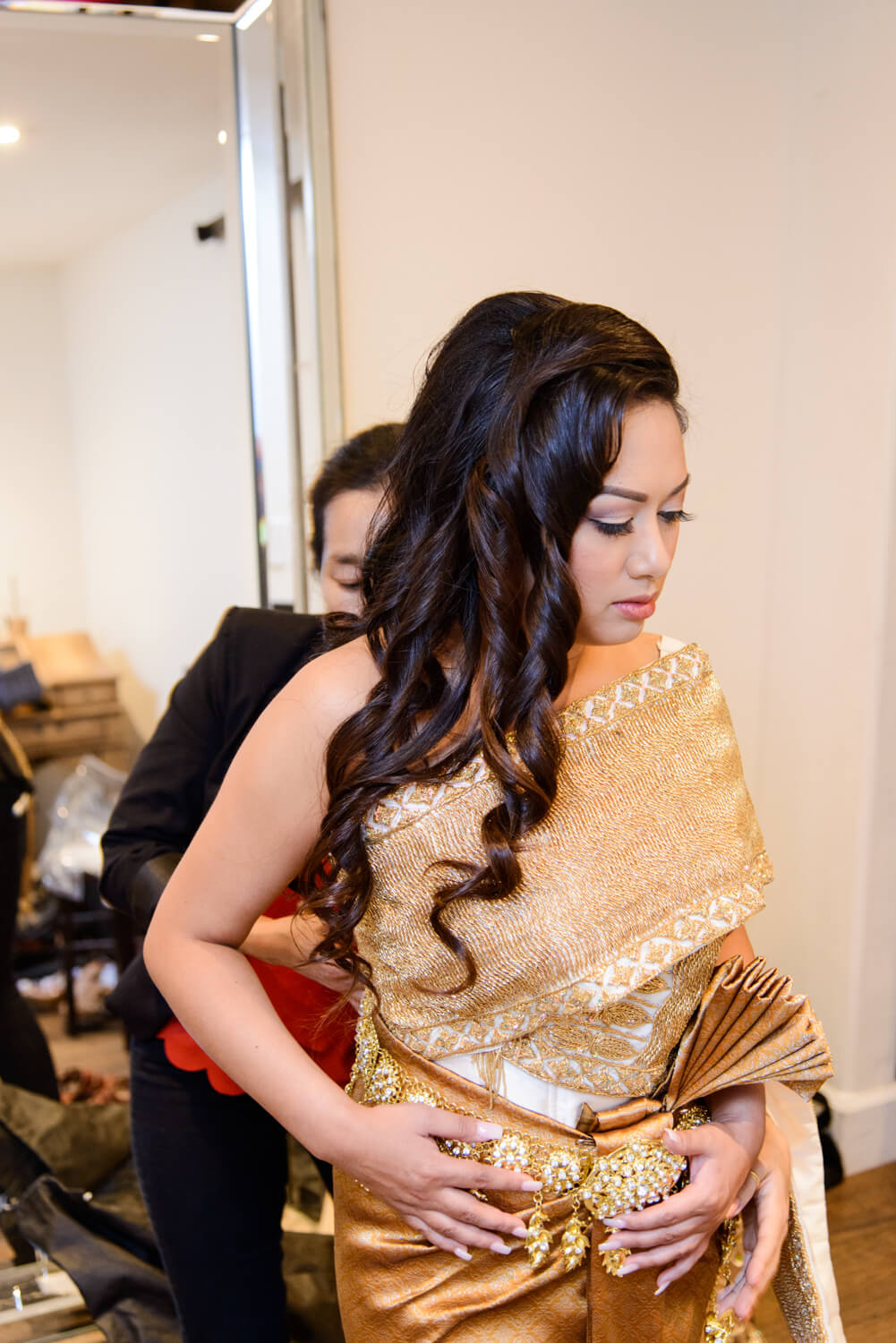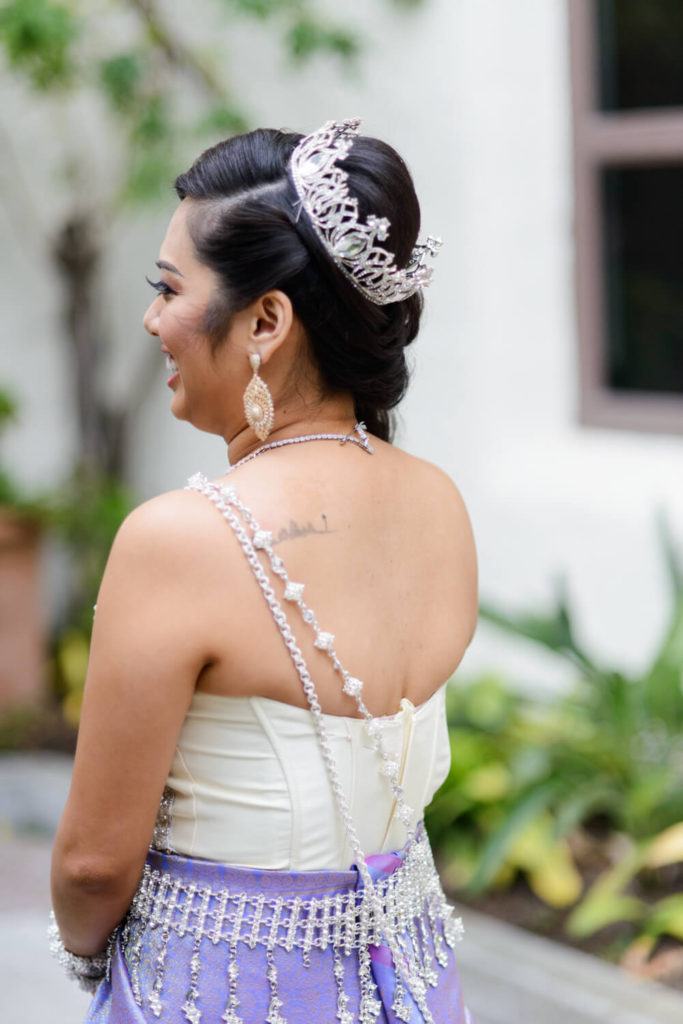The Traditional Cambodian wedding (Khmer) is one of the most important events in the lives of young people. It’s a very colorful and spectacular event. In Cambodia traditionaly is very religious. Most of the population (approximately 90%) practice Buddhism. Therefore, it is customary to read traditions and observe all rites here.

All the Cambodian weddings that I photograph are slightly different from each other and I wanted to find out more about original traditions. I read as much as I could find on english speaking resources and put everything here. I thought it would be better to get to the roots and look not at Cambodia American weddings but rather to the weddings in Cambodian itself. We are going to talk about Traditional Khmer wedding the way it celebrates for thousand of years. And you can decide what part of it you want to follow and incorporate in your special day. Let’s get started!
In the past, Cambodian girls tried to get married until the age of 25. Today, more women are pushing this frontier, favoring education, careers, and other priority aspects.
According to all the canons, those lucky couples, who have already decided on the companion of life, expect the next important stage of life – the wedding organization. Traditionally, the Khmer celebrate loud, colorful, expensive, and rich! There is no place for a small intimate wedding. In Cambodian weddings, it is common to call hundreds of guests.

Typically, a Khmer traditional wedding lasts for three days. Today, some couples manage to hold everything under 1-2 days. During this time, all traditions are observed and newlyweds acquire a new status.
Let’s plunge into Cambodia’s national flavor and move to the behind-the-scenes celebration of the Khmer wedding.
Cambodian Engagement
The important point of any marriage and the Khmer wedding as well is the engagement. This is an important day when families of young people agree on an upcoming celebration. On this day, sweethearts solemnly declare their willingness to marry and associate their further life with each other. This is a responsible moment since divorces in Cambodia are rare enough. On the eve of the day of engagement, relatives from the groom’s side bring gifts in the form of trays with fruit to the bride’s house. These are whole works of art on trays! The variety is striking – about 50 kinds of fruit!
At dawn the next day, relatives go to the temple. The morning service highlights fruit and the comers receive a blessing.



Upon return to the bride’s house, the engagement party continues. The parties agree on the upcoming event.
An important person at the engagement is a monk (astrologer, clairvoyant). The Khmers believe that the date of the marriage greatly affects subsequent life in the marriage. Therefore, the choice of date is taken seriously. The monk juxtaposes the horoscopes of the young and chooses favorable days for the wedding. It is believed that the ceremony is better to be held in a month that counts 30 days. And in the rainy season, it is better to abandon the celebration altogether. Also, there are times when the stars recommend to postpone the wedding for months, and even the whole year!
First day of Cambodian wedding
I photograph all sorts of scenarious. Starting from the smallest 8 hours wedding and going all the way to 5 day celebration in 3 different cities, 10-14 hours each day. In one day wedding an engagement takes 40 min and in 5 days wedding it’s half of the day. It’s all depend on how much you willing to invest in your special day in terms of budget and time.
This day is known for fruit, gifts, and fun. From deep night until dawn, makeup artists and hairdressers work over the bride. Besides, the bride and groom have to change several outfits. But about it later.
On the first day, there are three key points to be held.
Dowry Ceremony
In the morning, the groom and his relatives go to the bride’s house to hand over the dowry. Traditionally it is cash equivalent or certain gifts. The more gifts the bride’s family receives, the more respect the young man shows the beloved’s parents and shows his financial welfare.
For Cambodians, this is important because the union is not only between a man and a woman, but it is also a fusion of two big families. It’s somewhat similar to Vietnamese and Filipino weddings




Worth noting that the Groom recive the best treatments in Cambodian wedding out of all. I’m not quite sure why 🙂 Let me know in the comments if you do.
Monk’s Blessing
Another important ritual is the blessing of a monk. It sis accompanied by floral water sprinkling and instructions. Guests should keep quiet, and the young bow their heads and hold hands. Instead of Monk it could be a priest or grand parents.



Parent veneration
The bride and groom pay tribute to their parents. Thanking them for raising them and doing everything up until this moment. Children present fruits and sweets to their parents and take care of them and pay due attention. In doing so, a young couple holds umbrellas over their parents – a kind of cover.
This day takes place at the bride’s house. Everyone greets each other, even if they’ve known for many years! Also present at the celebration is a presenter. Only he doesn’t hold various competitions for creativity and speed. He captivates guests with Cambodian stories, parables, and short stories.



The second day. Cambodian wedding ceremony.
This day is generally considered religious. The newlyweds and their relatives go to the temple where traditional Cambodian wedding ceremony, recitation of sutras, and mantras occur.
If the bride or groom professes Catholicism, the ceremony may be held in a Catholic temple.
The second day of celebration also has its own features.



Groom procession
The so-called groom parade. On the second day, the newlywed spouse and his family come to the bride’s house to greet his wife and parents and give gifts. Guests also arrive with gifts – silver trays of fruit. At the house of the bride, they are usually put on them on the ground. When the young wife leaves the house, she will perform a dance between these trays, thus chanting her lover’s wealth.
It’s incredibly important part of the wedding and photographer has to follow it all the way. It’s better to be a part of the crowd. If you missed it it might be hard to get in.






Homage of ancestors
Cambodians need to observe traditions and honor their ancestors. Therefore, another essential element of the wedding celebration is the ceremony of honor of the ancestors. To do this, newlyweds become at the altar of ancestors, which is in almost every house. They bow their heads and present food and tea. Meanwhile, a family representative encourages the ancestors to “get acquainted” and “accept” a new family member.




Haircutting ceremony
Cutting a few strands of hair from the bride and groom’s head symbolizes cleansing and clipping everything bad and unnecessary, and moving to a new stage in life as husband and wife.



The third day of Cambodian wedding
The third day of celebrations takes place in the restaurant or venue. And there are a few nuances here, too.
Receiving Blessings
All married couples willing to take part in this ceremony. They form a circle in the center of which the newlyweds are located. Three candles are then passed in a circle seven times. This ceremony symbolizes the transfer of experience, well-being and happiness of family life from couples with seniority.
Note to a photographer. It could happened outside of reception aria and it might be not on the timeline as well. Spontaneous things happened in general on Cambodian weddings and you have to be mindful of that. Circle is very important and has to be visible on photos!


The knot-tying ceremony
It is the closing ceremony of the Cambodian wedding. The specifics of it are that guests and family members tie red silk thread on the bride and groom’s wrists. The red thread symbolizes the protection of a young family, happiness, well-being for years to come. I also saw that ritual during the ceremony at the church once.


Unusual wedding attribute – Cambodian sword
An important attribute at a Cambodian wedding is the sword. The origins of this wedding element originate from the oldest legend, “Holding the Knife.” According to legend, one high-ranking knight at Pirinsei Palace fell in love with the farmer’s daughter and promised to marry her in three months. And as a confirmation of his intentions, left a bar of gold. But time expired, and the knight never appeared. The father decided to extradite his daughter for the neighbor’s guy. But on the day of the marriage, the knight appeared and, in a rush of anger, killed the groom. At the ceremony, the priest realized the sword’s power and vengeance and how fates can crumble in one moment. Since then, the sword has been used in wedding ceremonies as a symbol of loyalty and protection from the Estates.

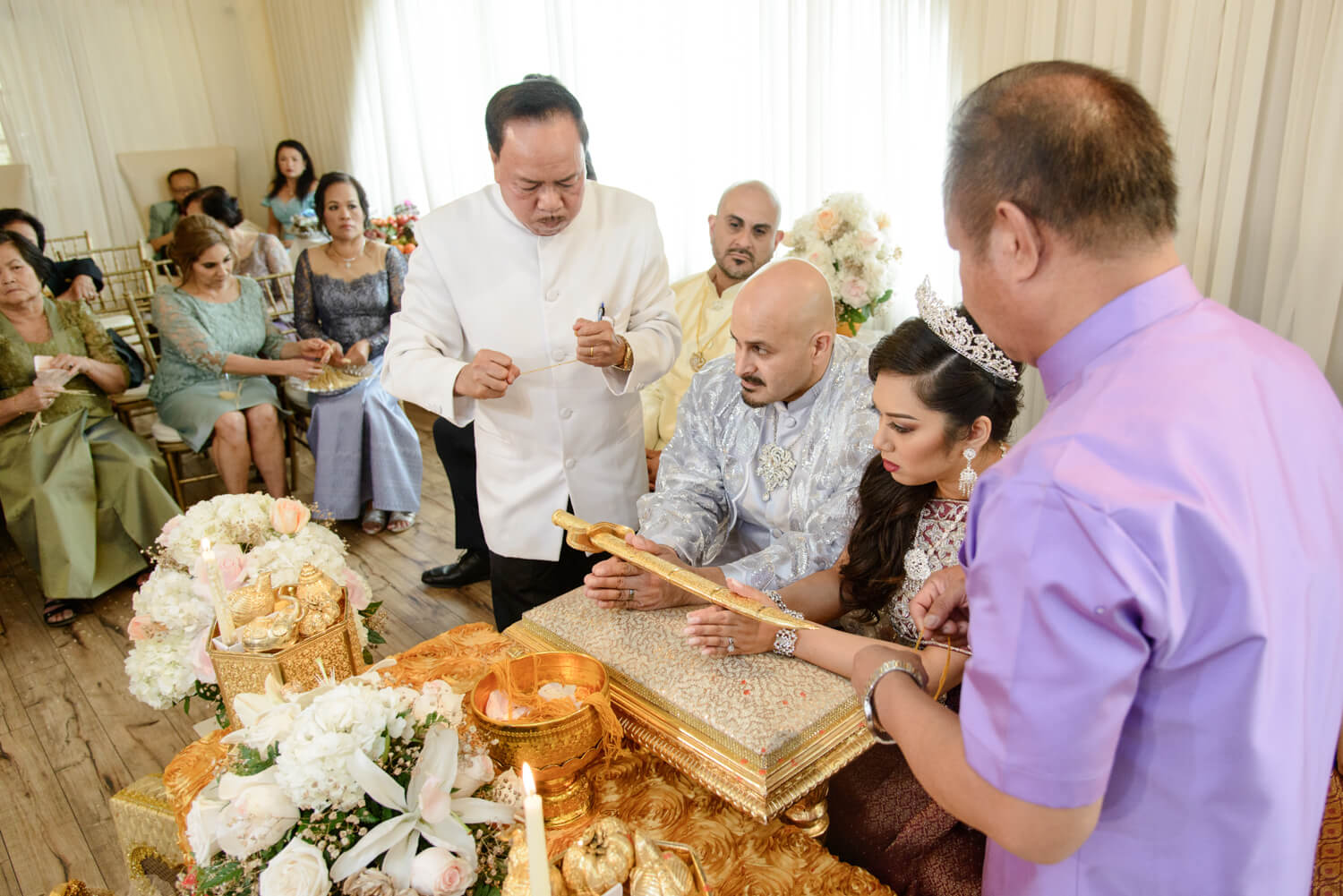


Cambodian wedding gifts
On this issue, Cambodians are conservative enough and do not seek to surprise with unusual gifts. It is usually donated money in beautiful envelopes. Moreover, at the entrance to the celebration place, a couple of witnesses clearly write down in a special notebook, the amount donated by this or that guest. In the future, when the couple is invited to a wedding to a guest, he will be given exactly the same amount of money.
Khmer Traditional wedding clothes
Groom and Bride’s Clothing deserves separate attention. After all, it is customary to change outfits several times throughout the wedding, some couples change up to 7 times for the whole holiday. This once again confirms the pomp of the celebration and highlights the national flavor.
The bride is sure to appear in a traditional costume. It consists of a Kompot bottom (skirt) and a top (top or shirt). Traditional outfits are made of expensive high-quality silk with gold thread. They have a bright color: red, magenta, gold, yellow, green or blue. Dresses impress with their beauty and luxury: appliques, stone inlays, embroidery…
Bride’s outfits can be of different colors and styles. It is important that there is a complete change of image – hairstyles, makeup and jewelry from the change of dress. Complete reincarnation. Five to 7 people come to help the bride to change her appearance.
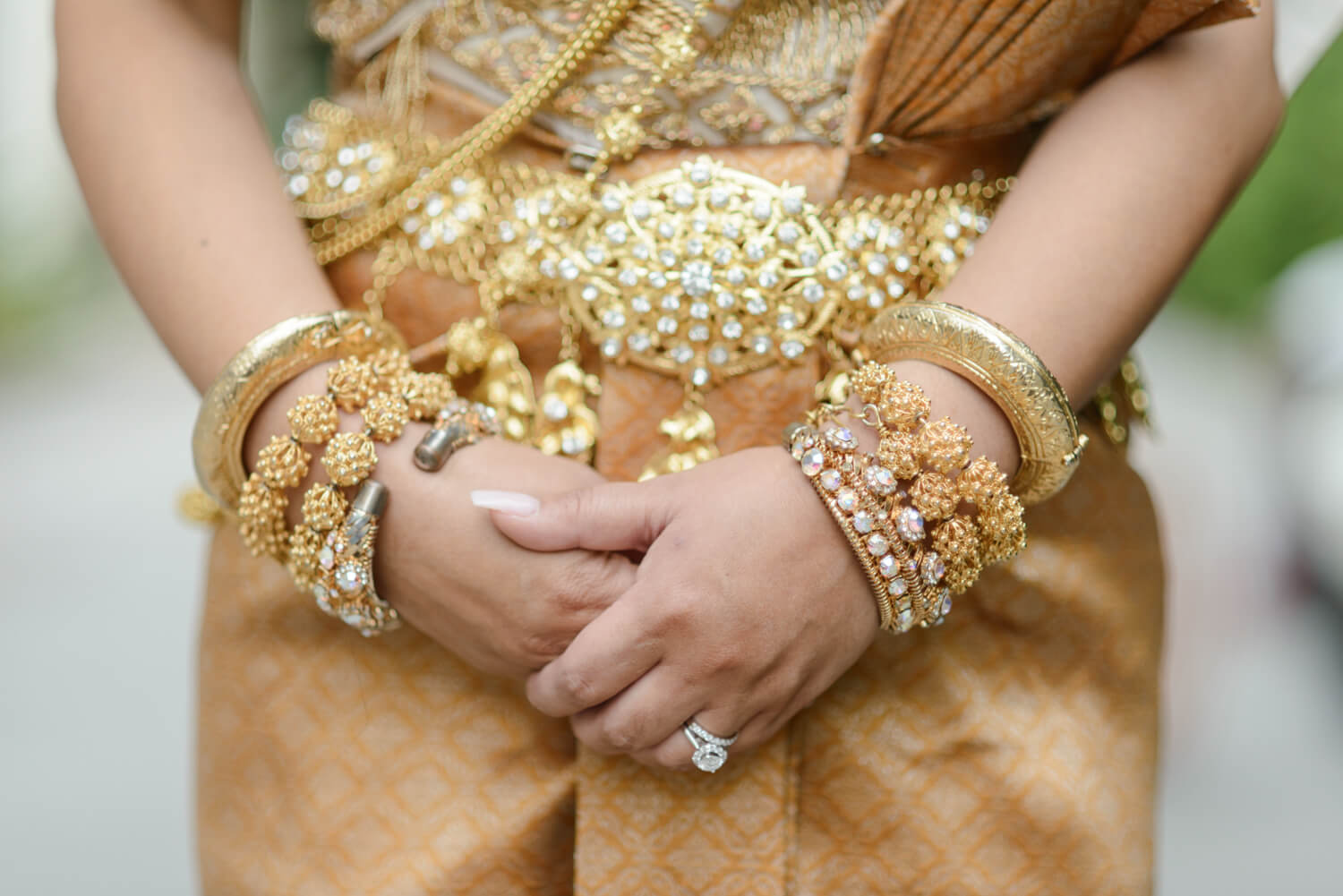








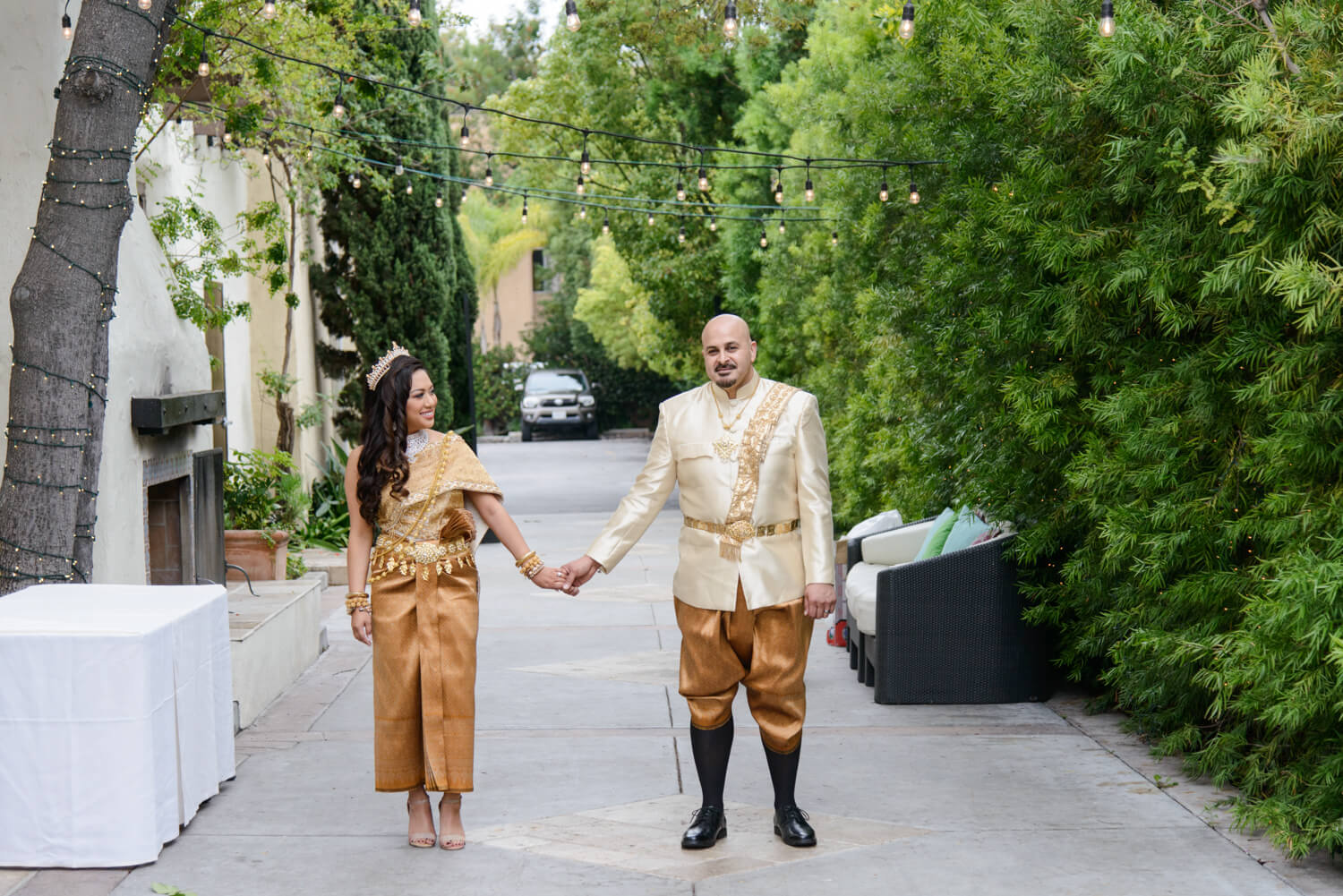








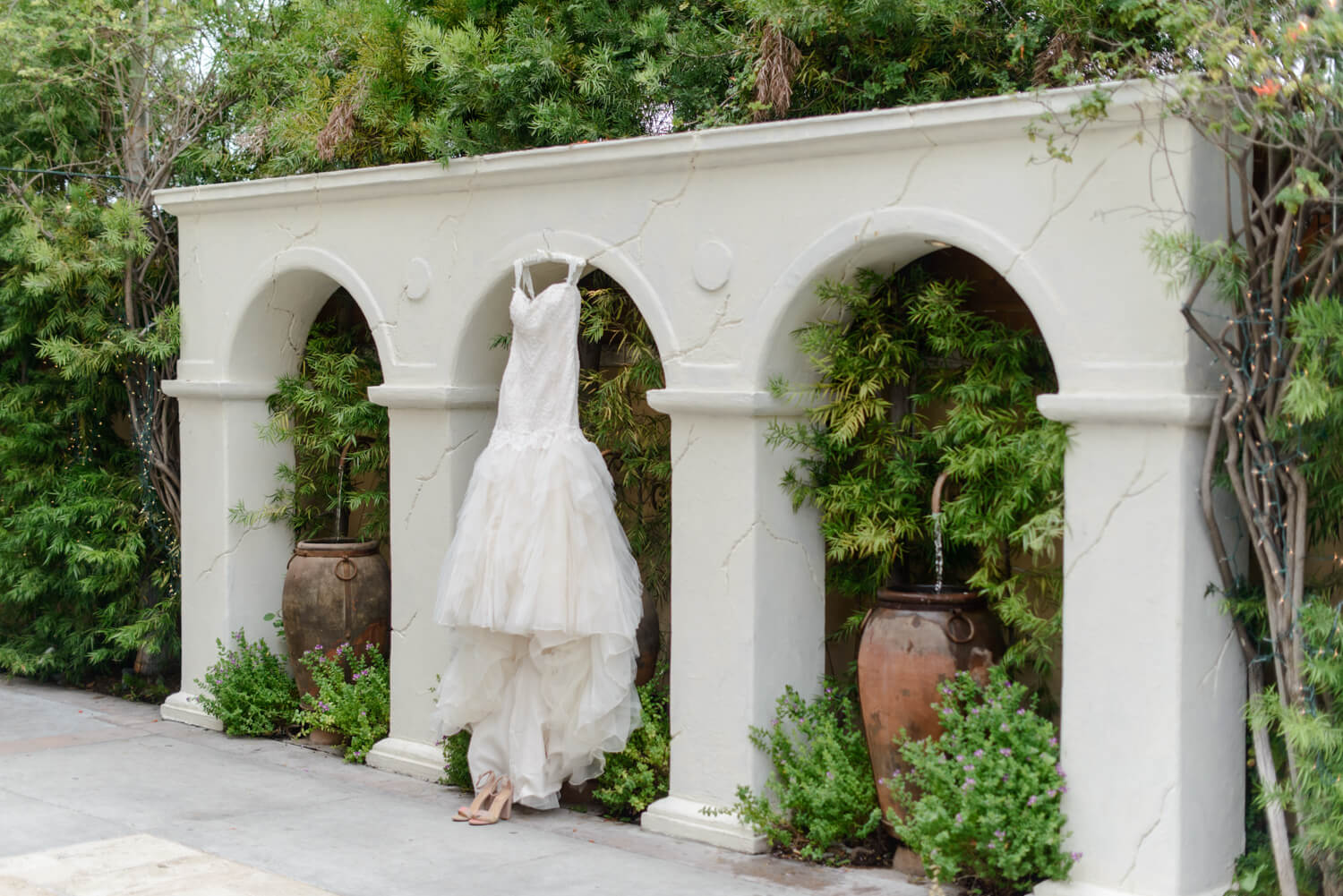





More often, for the reception part, couples are wearing western versions of wedding outfits – a traditional white dress and a dark man’s suit.
Another exciting tradition with dressing is that the bride and groom exchange elements of Clothing. And when the groom enters the bride’s house, he must hold on to his sweetheart’s scarf.
These rituals originate with ancient legend of Prince Thaong. Legend has it that it was the bride’s skirt that saved him from doom. Prince Thaong intended to take Princess Tewtei, the daughter of a dragon sea lord, as consort. The king’s father decided to test the power and capabilities of his daughter’s elect and ordered his subject to attack the young man. But the thoughtful girl guessed about her father’s intentions and hurried to shield her lover from trouble. She put her skirt on him. Thus Prince Thaong remained alive and unharmed.
Cambodian wedding treats
The banquet is accompanied by national treats in the form of seafood dishes, all sorts of salads and snacks, hot and desserts. All guests drink, eat, and dance widowly.
First courses take pride of place in Cambodian cuisine. Even at a wedding you can find soups of various flavors.
The most popular dish of Khmer cuisine is Amok. It is a fish soufflé baked in banana leaves. The secret ingredient is coconut milk and curry sauce. There are different ways of cooking amok: with fish or shrimp, more liquid or thicker. But the main thing is it always has a spicy and rich taste.


Lock varnish – mouth-watering pieces of beef, pre-marinated, and quickly fried on fire. Served on a pillow of vegetables.
Khmer curry does not have the intense sharpness that is typical of Asian cuisine. On the contrary, this curry is sweet and meadow. Prepare it with the addition of chicken, lots of coconut cream, and milk. A special notes of the dish is given by the combination of batat, turmeric and ginger.
Crab seasoned with Kampota pepper – a combination of tender crab meat and local pepper.
Nom bath chok is famous as an excellent side dish to meat or curry. This dish is sotoite of rice noodles, rice sprouts seasoned with fresh cucumber, mint, and basil. All that deliciousness is exquisitely served on banana leaves. Looks stunningly!
From desserts, cralan is widely known. Sweet and airy. It is a rice pudding on coconut milk baked in a bamboo stem-tube.
Notably, you won’t find traditional cakes at Cambodian weddings. It is usually artfully built slides with all sorts of fruits: watermelons, papaya, pineapples, mangoes, durian, guava, rambutan, pomelo, mongoostin, camerin, khanau, longan, jack fruit, sapodilla.
Wedding dance
The first dance of husband and wife is a touching and beautiful sight. It lasts, surprisingly, 20 minutes. Sounds a slow love song. Prayer phrases and instructions can be heard in it. The groom with the bride slowly dance and move between guest tables. It is very important to perform smooth and filigree movements with your fingers. At the end of the song, the young bow to the guests.
At first glance, the wedding process in Cambodia can seem complex and intricate. But such an event only happens once in a lifetime. And for the Khmer, it is important to mark it with all pomposity and sumptuousness.





Despite the fact that according to ancient traditions the wedding is celebrated three days, today young couples prefer to set aside for a day or two for a walk and make it as full as possible. After all, in addition to ancient traditions, the program is complemented by modern elements: it is a photo shoot of a young couple, morning boudoir of the bride, photo with guests, throwing a bouquet, presentation of the wedding cake and so on. Modern progressive brides make a plan to hold the most important event of life at their own discretion.

Conclusion

For me as for photographer it’s crucial to know all traditions to be in the right place in the right time. Photographer has to setup the light and be prepare for the action. You have to know exactly what you doing and I believe it’s not the brides job to walk you through this things.



